Processes and threads
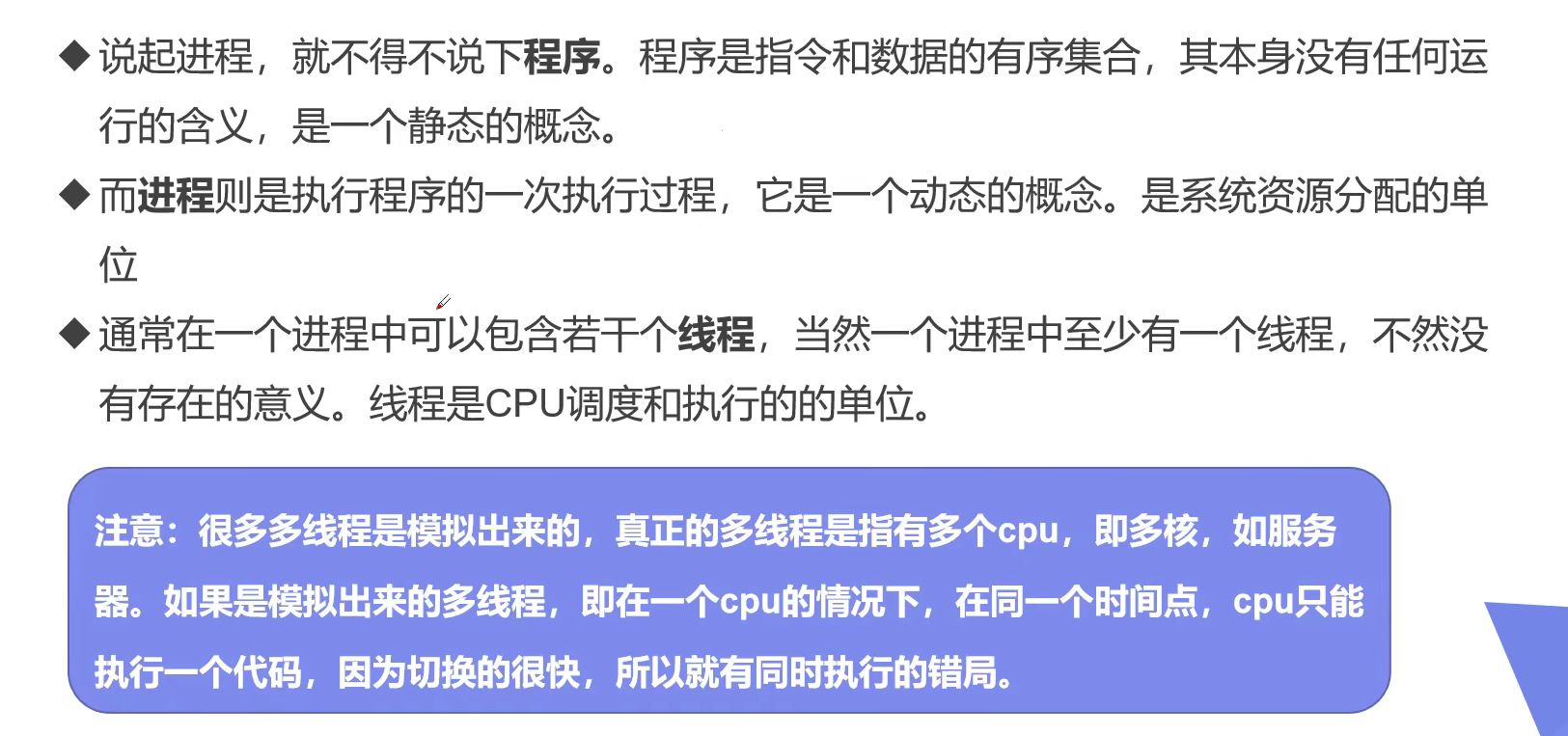
Example code:
package com.gavin.demo01;
public class TestThread extends Thread{
@Override
public void run() {
//run cube thread
for (int i = 0; i < 20; i++) {
System.out.println("I'm looking at the code---" + i);
}
}
public static void main(String[] args) {
//The main method is a main thread
//Create a thread object
TestThread testThread = new TestThread();
//Call the start method to start the thread
testThread.start();
for (int i = 0; i < 1000 ; i++) {
System.out.println("I'm learning multithreading---" + i);
}
}
}
Execution results:

It can be seen that the run method and the main method are executed at the same time and are scheduled by the CPU, resulting in the problem of thread preemption
Sample code for downloading pictures using multithreading:
package com.gavin.demo01;
import org.apache.commons.io.FileUtils;
import java.io.File;
import java.io.IOException;
import java.net.URL;
public class TestThread2 extends Thread{
private String url;
private String name;
public TestThread2(String url, String name) {
this.url = url;
this.name = name;
}
@Override
public void run() {
WebDownLoad webDownLoad = new WebDownLoad();
webDownLoad.down(url, name);
System.out.println("The downloaded file is:" + name);
}
public static void main(String[] args) {
TestThread2 testThread = new TestThread2("https://img-blog.csdnimg.cn/ff1034bf4ec944ed9b9fefb5d9bbeb2c.png?x-oss-process=image/watermark,type_d3F5LXplbmhlaQ,shadow_50,text_Q1NETiBAR2F2aW5DaGVuXw==,size_20,color_FFFFFF,t_70,g_se,x_16#pic_center", "1.jpg");
TestThread2 testThread2 = new TestThread2("https://img-blog.csdnimg.cn/98a80c1487354509baa94b1522e22fe6.png?x-oss-process=image/watermark,type_d3F5LXplbmhlaQ,shadow_50,text_Q1NETiBAR2F2aW5DaGVuXw==,size_20,color_FFFFFF,t_70,g_se,x_16#pic_center", "2.jpg");
TestThread2 testThread3 = new TestThread2("https://img-blog.csdnimg.cn/30244b9ad1eb40d6a2c6f757e458d343.png?x-oss-process=image/watermark,type_d3F5LXplbmhlaQ,shadow_50,text_Q1NETiBAR2F2aW5DaGVuXw==,size_20,color_FFFFFF,t_70,g_se,x_16#pic_center", "3.jpg");
testThread.start();
testThread2.start();
testThread3.start();
}
}
class WebDownLoad{
public void down(String url, String name) {
try {
FileUtils.copyURLToFile(new URL(url), new File(name));
} catch (IOException e) {
e.printStackTrace();
System.out.println("IO Abnormal, down Method error");
}
}
}
Execution results:

It can be seen that after the program is started, the three threads are executed at the same time, not in the order from top to bottom, so the printing order shown in the figure appears.
Implement Runnable interface
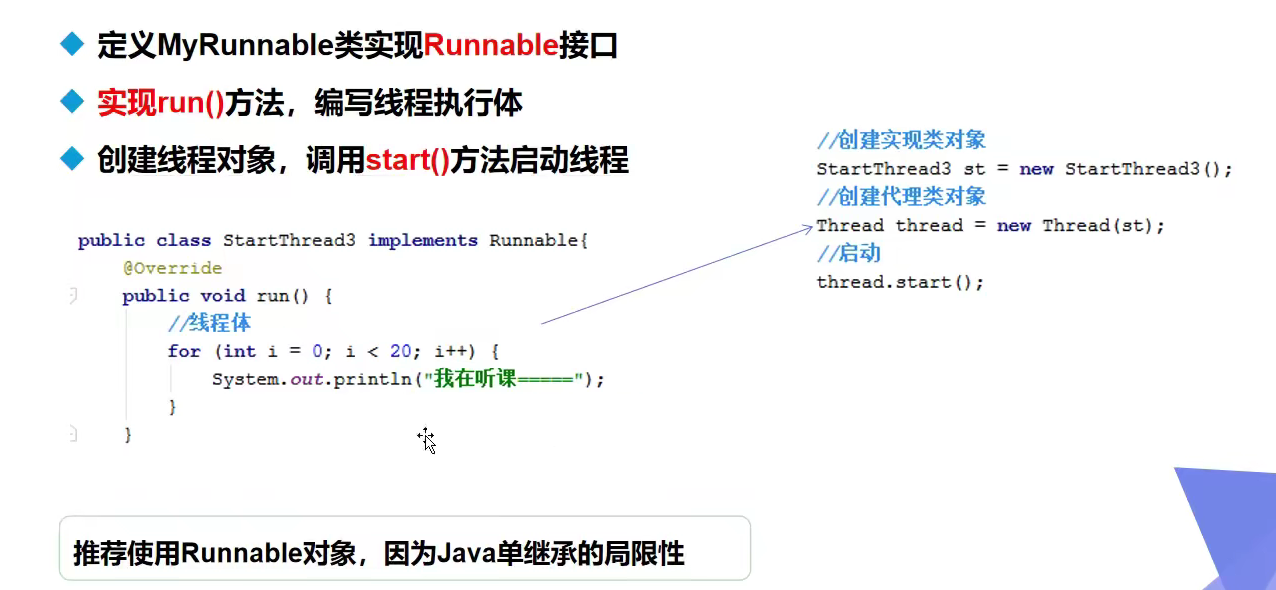
Example code:
package com.gavin.demo01;
public class TestRunnable implements Runnable{
@Override
public void run() {
//run method thread
for (int i = 0; i < 20; i++) {
System.out.println("I'm looking at the code---" + i);
}
}
public static void main(String[] args) {
//The main method is a main thread
//Create a thread object
TestRunnable testRunnable = new TestRunnable();
//Pass in the class that implements the Runnable interface
Thread thread = new Thread(testRunnable);
//Call the start method to start the thread
thread.start();
for (int i = 0; i < 1000 ; i++) {
System.out.println("I'm learning multithreading---" + i);
}
}
}
Execution results:

Use the Runnable interface to download images
Example code:
package com.gavin.demo01;
import org.apache.commons.io.FileUtils;
import java.io.File;
import java.io.IOException;
import java.net.URL;
public class TestRunnable2 implements Runnable{
private String url;
private String name;
public TestRunnable2(String url, String name) {
this.url = url;
this.name = name;
}
@Override
public void run() {
WebDownLoad2 webDownLoad2 = new WebDownLoad2();
webDownLoad2.down(url, name);
System.out.println("The downloaded file is:" + name);
}
public static void main(String[] args) {
TestThread2 testThread = new TestThread2("https://img-blog.csdnimg.cn/ff1034bf4ec944ed9b9fefb5d9bbeb2c.png?x-oss-process=image/watermark,type_d3F5LXplbmhlaQ,shadow_50,text_Q1NETiBAR2F2aW5DaGVuXw==,size_20,color_FFFFFF,t_70,g_se,x_16#pic_center", "1.jpg");
TestThread2 testThread2 = new TestThread2("https://img-blog.csdnimg.cn/98a80c1487354509baa94b1522e22fe6.png?x-oss-process=image/watermark,type_d3F5LXplbmhlaQ,shadow_50,text_Q1NETiBAR2F2aW5DaGVuXw==,size_20,color_FFFFFF,t_70,g_se,x_16#pic_center", "2.jpg");
TestThread2 testThread3 = new TestThread2("https://img-blog.csdnimg.cn/30244b9ad1eb40d6a2c6f757e458d343.png?x-oss-process=image/watermark,type_d3F5LXplbmhlaQ,shadow_50,text_Q1NETiBAR2F2aW5DaGVuXw==,size_20,color_FFFFFF,t_70,g_se,x_16#pic_center", "3.jpg");
Thread thread = new Thread(testThread);
Thread thread2 = new Thread(testThread2);
Thread thread3 = new Thread(testThread3);
thread.start();
thread2.start();
thread3.start();
}
}
class WebDownLoad2{
public void down(String url, String name) {
try {
FileUtils.copyURLToFile(new URL(url), new File(name));
} catch (IOException e) {
e.printStackTrace();
System.out.println("IO Abnormal, down Method error");
}
}
}
Execution results:

Understanding concurrency problems
Example code for multithreading to operate the same object:
package com.gavin.Demo02;
//Multithreading operates on an object at the same time
//Example of buying a train ticket
public class TestRunnable3 implements Runnable{
//Number of votes
private int ticketNumber = 10;
@Override
public void run() {
while (true) {
if (ticketNumber <= 0) {
break;
}
try {
Thread.sleep(200);
} catch (InterruptedException e) {
e.printStackTrace();
}
System.out.println(Thread.currentThread().getName() + "-->Got the second" + ticketNumber-- + "Ticket");
}
}
public static void main(String[] args) {
TestRunnable3 testRunnable = new TestRunnable3();
Thread thread = new Thread(testRunnable, "Xiao Ming");
thread.start();
Thread thread2 = new Thread(testRunnable, "teacher");
thread2.start();
Thread thread3 = new Thread(testRunnable, "Scalpers");
thread3.start();
}
}
Execution results:

It can be seen that Xiao Ming and the scalpers grabbed the 9th ticket at the same time, and Xiao Ming and the teacher grabbed the 5th ticket at the same time. There is a big problem, which needs to be solved with concurrent knowledge in the future.
Tortoise rabbit race example
Example code:
package com.gavin.Demo02;
//Example of simulated tortoise rabbit race
public class Race implements Runnable{
private static String winner;
@Override
public void run() {
for (int i = 1; i <= 100; i++) {
//Let the rabbit rest for 5 milliseconds
if (Thread.currentThread().getName().equals("rabbit") && i % 10 == 0) {
try {
Thread.sleep(5);
} catch (InterruptedException e) {
e.printStackTrace();
}
}
System.out.println(Thread.currentThread().getName() + "-->Run away" + i + "step");
Boolean flag = gameOver(i);
if (flag) {
break;
}
}
}
public Boolean gameOver(int steps) {
if (winner != null) {
return true;
} else {
if (steps >= 100) {
winner = Thread.currentThread().getName();
System.out.println("The winners are:" + winner);
return true;
}
}
return false;
}
public static void main(String[] args) {
Race race = new Race();
Thread thread = new Thread(race, "tortoise");
Thread thread2 = new Thread(race, " rabbit");
thread.start();
thread2.start();
}
}
Execution results:

With a piece of code to restore the classic tortoise and rabbit race story, it is true and good!
Implement Callable interface
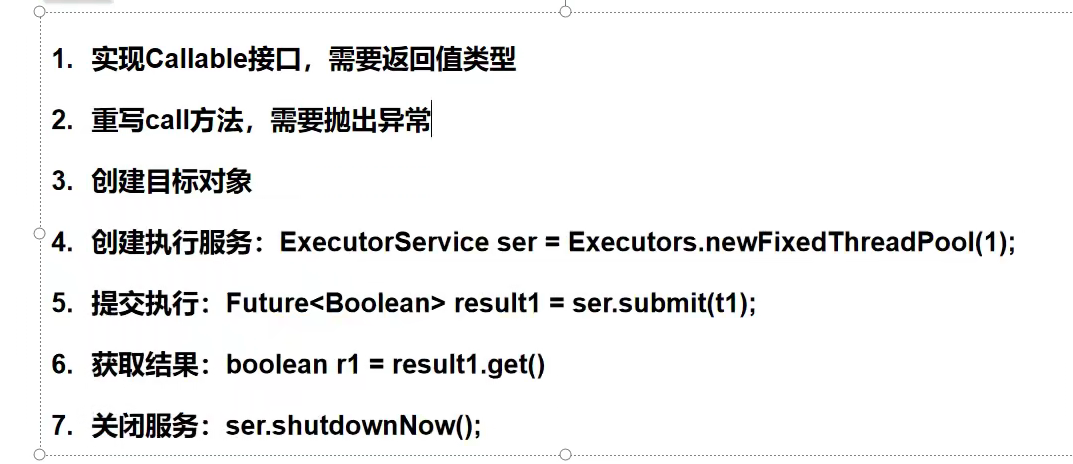
Example code:
package com.gavin.Demo02;
import org.apache.commons.io.FileUtils;
import java.io.File;
import java.io.IOException;
import java.net.URL;
import java.util.concurrent.*;
//Implement the Callable interface to download pictures
public class TestCallable implements Callable<Boolean> {
private String url;
private String name;
public TestCallable(String url, String name) {
this.url = url;
this.name = name;
}
@Override
public Boolean call() throws Exception {
WebDownLoad2 webDownLoad = new WebDownLoad2();
webDownLoad.down(url, name);
System.out.println("The downloaded file is:" + name);
return true;
}
public static void main(String[] args) throws ExecutionException, InterruptedException {
TestCallable testCallable = new TestCallable("https://img-blog.csdnimg.cn/ff1034bf4ec944ed9b9fefb5d9bbeb2c.png?x-oss-process=image/watermark,type_d3F5LXplbmhlaQ,shadow_50,text_Q1NETiBAR2F2aW5DaGVuXw==,size_20,color_FFFFFF,t_70,g_se,x_16#pic_center", "1.jpg");
TestCallable testCallable2 = new TestCallable("https://img-blog.csdnimg.cn/98a80c1487354509baa94b1522e22fe6.png?x-oss-process=image/watermark,type_d3F5LXplbmhlaQ,shadow_50,text_Q1NETiBAR2F2aW5DaGVuXw==,size_20,color_FFFFFF,t_70,g_se,x_16#pic_center", "2.jpg");
TestCallable testCallable3 = new TestCallable("https://img-blog.csdnimg.cn/30244b9ad1eb40d6a2c6f757e458d343.png?x-oss-process=image/watermark,type_d3F5LXplbmhlaQ,shadow_50,text_Q1NETiBAR2F2aW5DaGVuXw==,size_20,color_FFFFFF,t_70,g_se,x_16#pic_center", "3.jpg");
//Create execution service
ExecutorService executorService = Executors.newFixedThreadPool(3);
//Submit for execution
Future<Boolean> r1 = executorService.submit(testCallable);
Future<Boolean> r2 = executorService.submit(testCallable2);
Future<Boolean> r3 = executorService.submit(testCallable3);
//Get results
boolean rs1 = r1.get();
boolean rs2 = r1.get();
boolean rs3 = r1.get();
System.out.println(rs1);
System.out.println(rs2);
System.out.println(rs3);
//Shut down service
executorService.shutdown();
}
}
class WebDownLoad2{
public void down(String url, String name) {
try {
FileUtils.copyURLToFile(new URL(url), new File(name));
} catch (IOException e) {
e.printStackTrace();
System.out.println("IO Abnormal, down Method error");
}
}
}
Execution results:

Static proxy mode
Example code:
package com.gavin.Demo03;
public class StaticProxy {
public static void main(String[] args) {
WeddingCompany weddingCompany = new WeddingCompany(new You());
weddingCompany.HappyMarry();
}
}
interface Marry {
void HappyMarry();
}
class You implements Marry {
@Override
public void HappyMarry() {
System.out.println("Today Happy oh");
}
}
class WeddingCompany implements Marry {
private Marry target;
public WeddingCompany(Marry target) {
this.target = target;
}
@Override
public void HappyMarry() {
before();
this.target.HappyMarry();
after();
}
public void before() {
System.out.println("yesterday Happy!!!");
}
public void after() {
System.out.println("tomorrow Happy!!!");
}
}
Execution results:

It can be seen that WeddingCompany, as a static proxy of You class, can call not only its own methods, but also the methods of proxy objects. This is the idea of static proxy.
Thread state
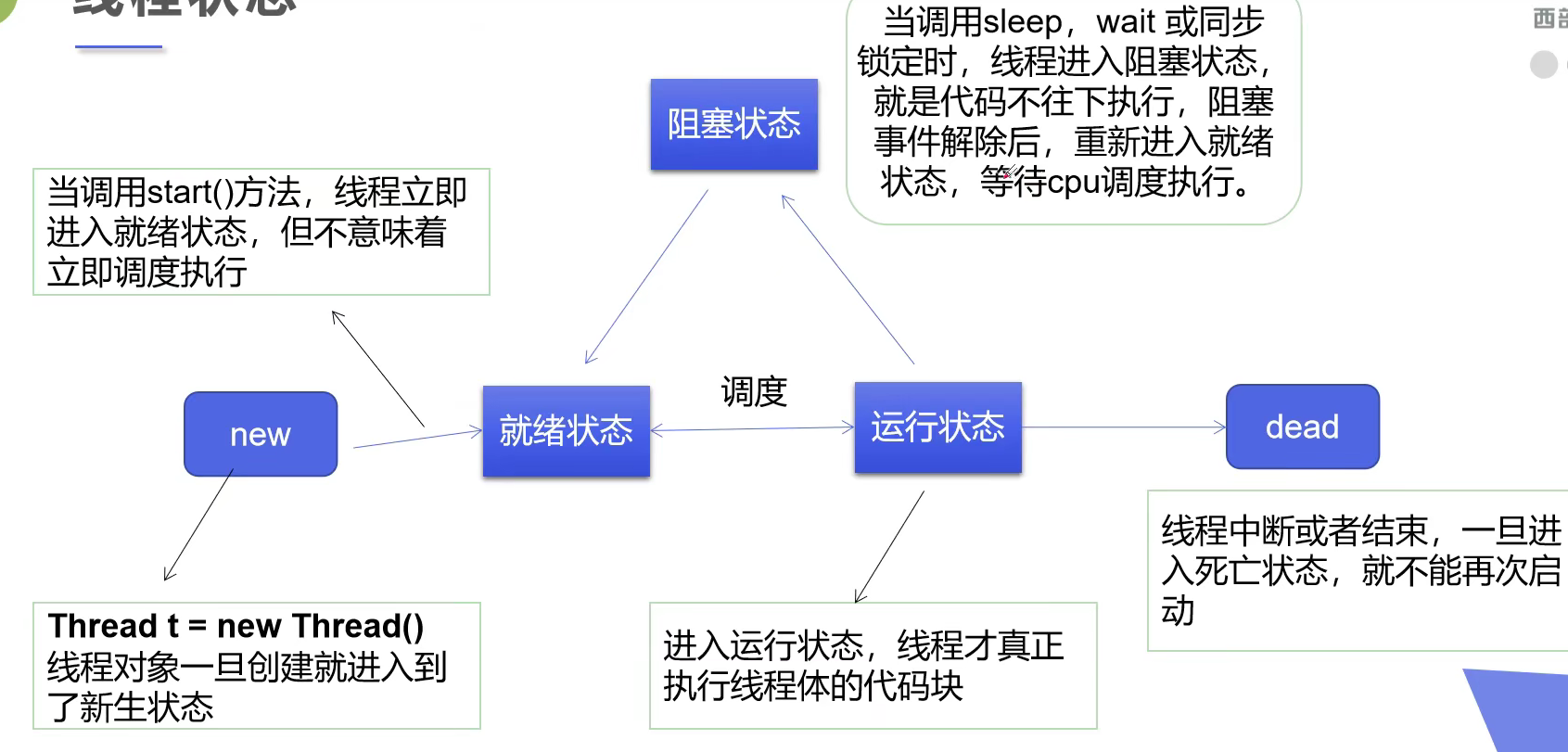
Thread stop
Use your own defined method to stop the thread
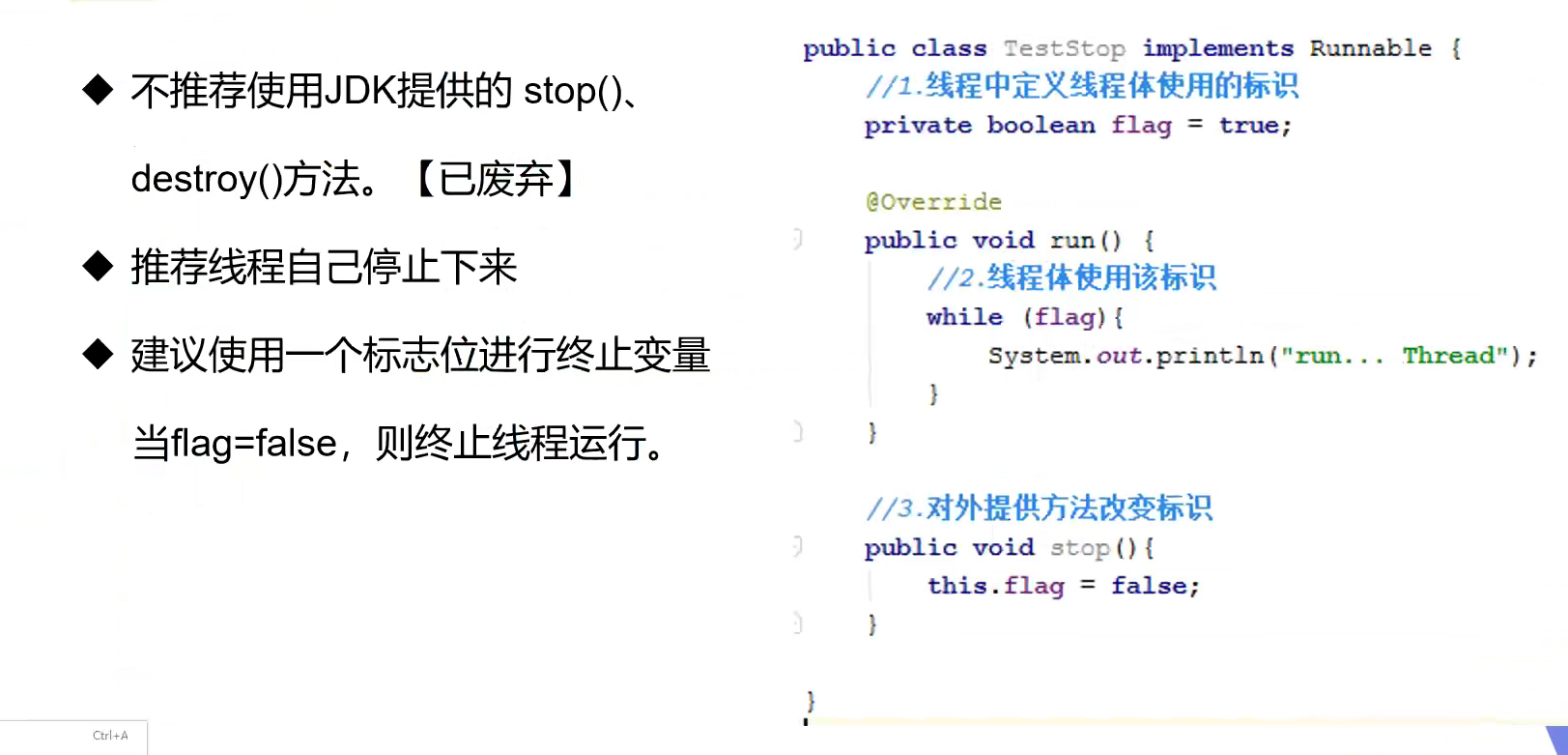
Example code:
package com.gavin.Demo04;
public class TestStop implements Runnable{
//Set an ID to stop the thread
private boolean flag = true;
@Override
public void run() {
int i = 0;
while (flag) {
System.out.println("Yes-->" + i++ + "second");
}
}
//Set an open method to stop the thread and convert the flag bit
public void stop() {
this.flag = false;
}
public static void main(String[] args) {
TestStop testStop = new TestStop();
Thread thread = new Thread(testStop);
thread.start();
for (int i = 0; i <= 100 ; i++) {
System.out.println("main Yes-->" + i + "second");
if (i == 90) {
//Call your own stop method to stop the thread
testStop.stop();
System.out.println("The thread has stopped");
}
}
}
}
Execution results:

It can be seen that when the main thread is executed for the 90th time, the user-defined thread stop method is called to stop the user-defined thread. At this time, the user-defined thread is executed only 63 times.
Thread sleep
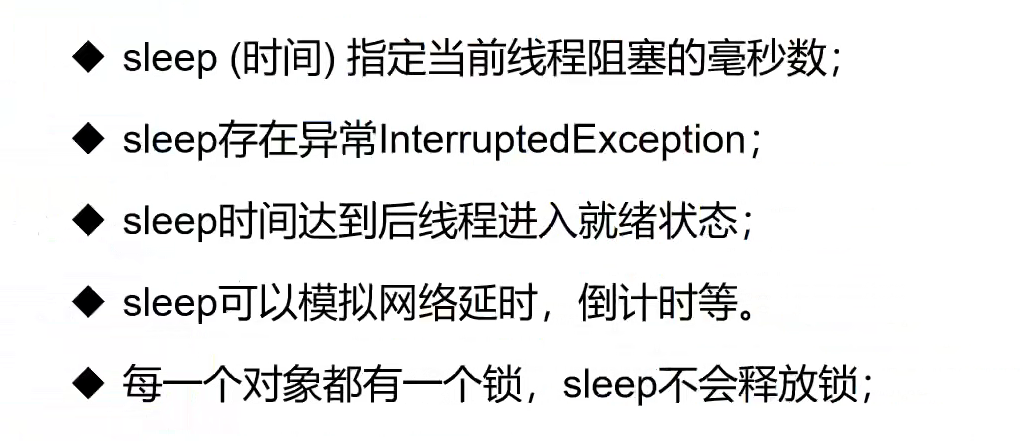
Use thread The sleep method completes the countdown function
Example code:
package com.gavin.Demo04;
public class TestSleep {
public static void main(String[] args) {
try {
tenDown();
} catch (InterruptedException e) {
e.printStackTrace();
}
}
//Use thread The sleep method completes the countdown function
public static void tenDown() throws InterruptedException {
int num = 10;
while (true) {
Thread.sleep(1000);
System.out.println(num);
num --;
if (num == 0) {
break;
}
}
}
}
Execution results:

Use thread The sleep method prints the current system time
Example code:
package com.gavin.Demo04;
import java.text.SimpleDateFormat;
import java.util.Date;
public class TestSleep2 {
//Use thread The sleep method prints the current system time
public static void main(String[] args) throws InterruptedException {
Date startTime = new Date(System.currentTimeMillis());
while (true) {
Thread.sleep(1000);
System.out.println(new SimpleDateFormat("HH:mm:ss").format(startTime));
startTime = new Date(System.currentTimeMillis());
}
}
}
Execution results:

Thread comity

Example code:
package com.gavin.Demo04;
public class TestYield {
public static void main(String[] args) {
MyYield myYield = new MyYield();
Thread thread = new Thread(myYield, "a");
Thread thread2 = new Thread(myYield, "b");
thread.start();
thread2.start();
}
}
class MyYield implements Runnable {
@Override
public void run() {
System.out.println(Thread.currentThread().getName() + "Thread starts execution");
//Thread comity
Thread.yield();
System.out.println(Thread.currentThread().getName() + "Thread stop execution");
}
}
Execution results:

It can be seen that thread a gives way to thread b when the program is executing
Thread enforcement
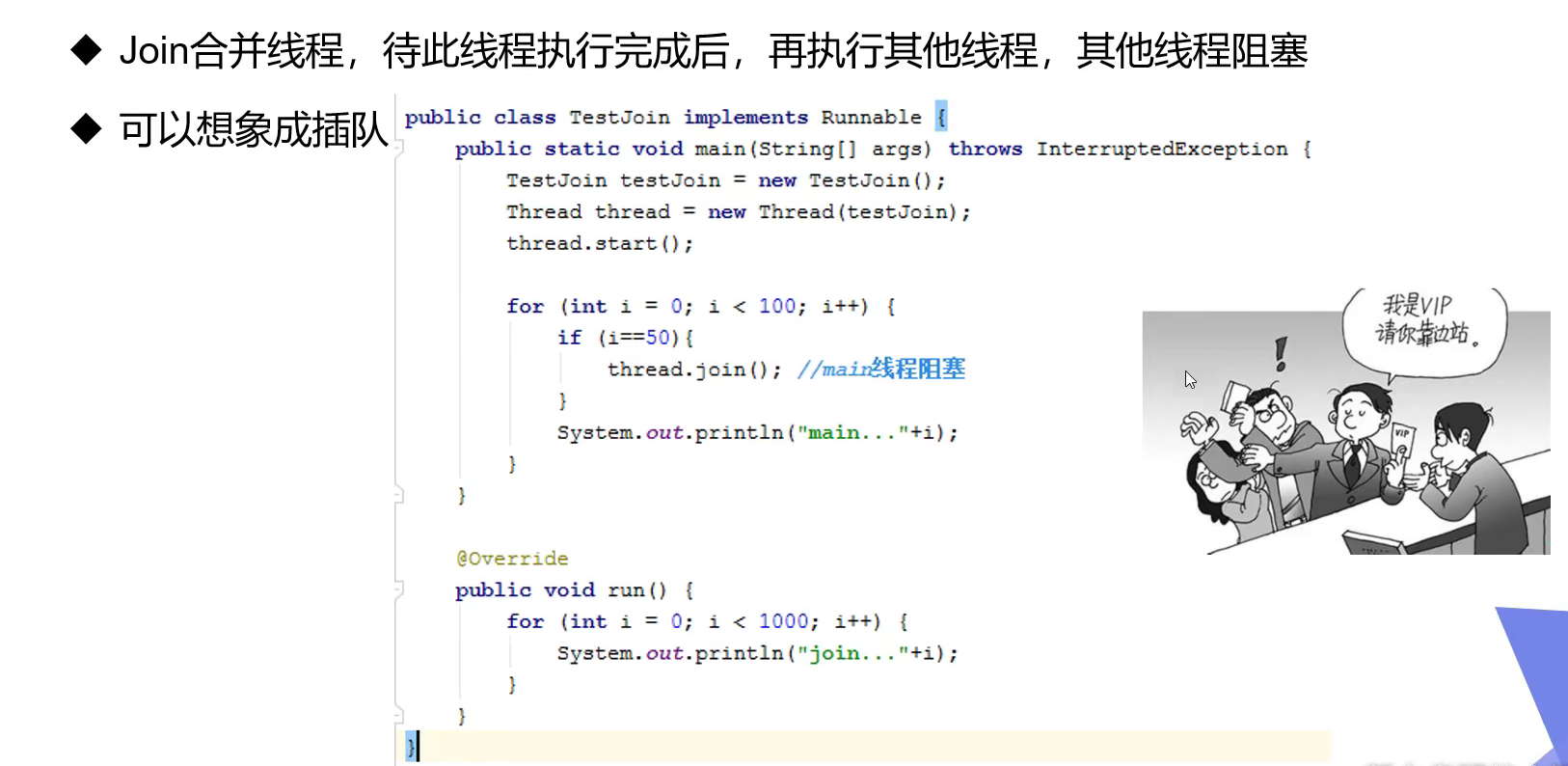
Example code:
package com.gavin.Demo04;
public class TestJoin implements Runnable{
@Override
public void run() {
for (int i = 1; i <= 100; i++) {
System.out.println("thread VIP coming-->" + i);
}
}
public static void main(String[] args) throws InterruptedException {
TestJoin testJoin = new TestJoin();
Thread thread = new Thread(testJoin);
thread.start();
//The main thread starts executing
for (int i = 1; i <= 500; i++) {
if (i == 20) {
//Thread queue jumping
thread.join();
}
System.out.println("main-->" + i);
}
}
}
Execution results:

Observe thread status
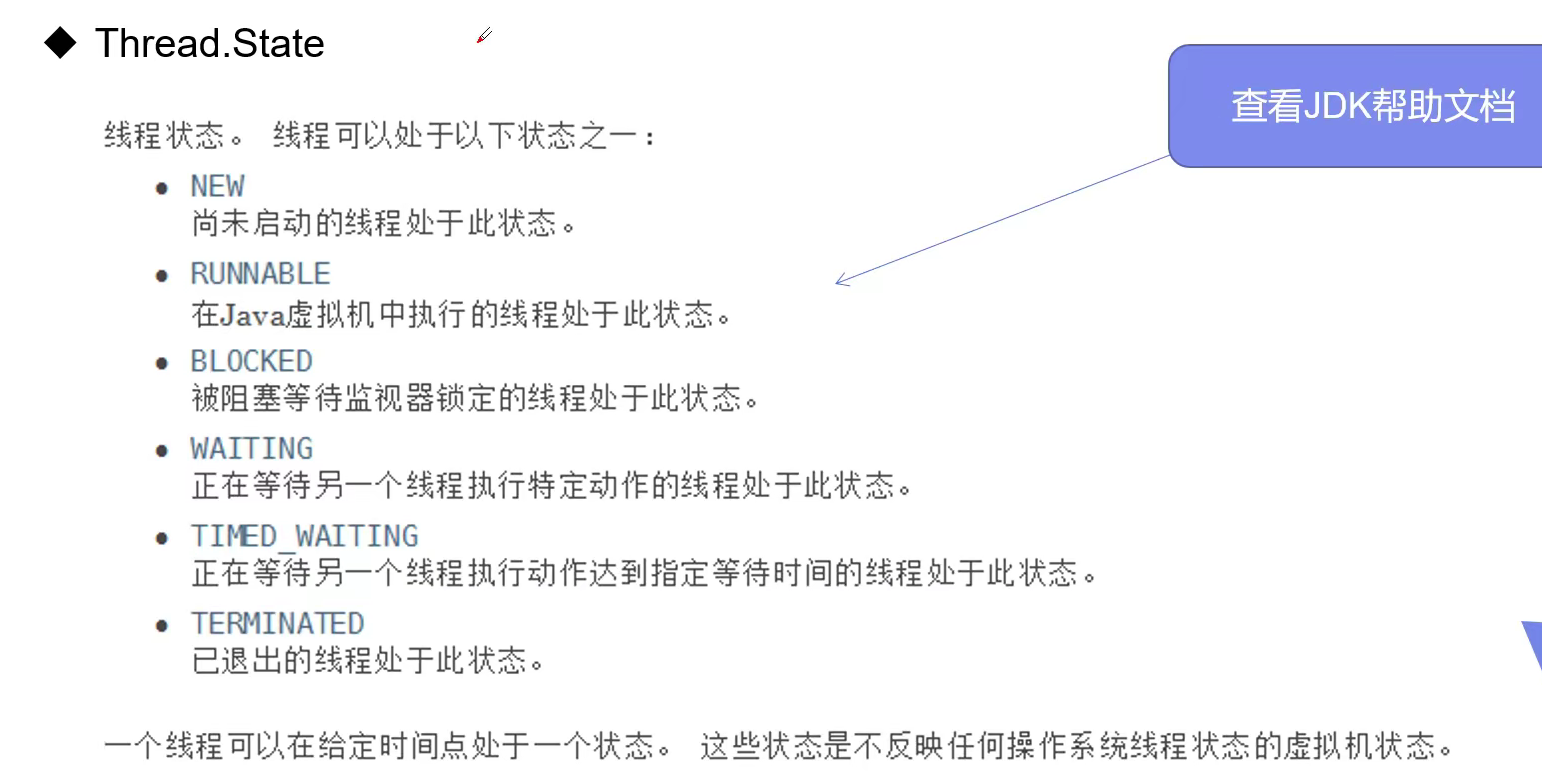
Example code:
package com.gavin.state;
public class TestState {
public static void main(String[] args) {
Thread thread = new Thread(() -> {
for (int i = 0; i < 5; i++) {
try {
Thread.sleep(1000);
} catch (InterruptedException e) {
e.printStackTrace();
}
}
System.out.println("//");
});
//Observe thread status
Thread.State state = thread.getState();
System.out.println(state); //NEW
//Observe the status after thread startup
thread.start();
state = thread.getState();
System.out.println(state); //RUN
//As long as the thread does not terminate, it will always output state
while (state != Thread.State.TERMINATED) {
try {
Thread.sleep(100);
//Update thread status
state = thread.getState();
//Output status
System.out.println(state);
} catch (InterruptedException e) {
e.printStackTrace();
}
}
}
}
Execution results:

thread priority
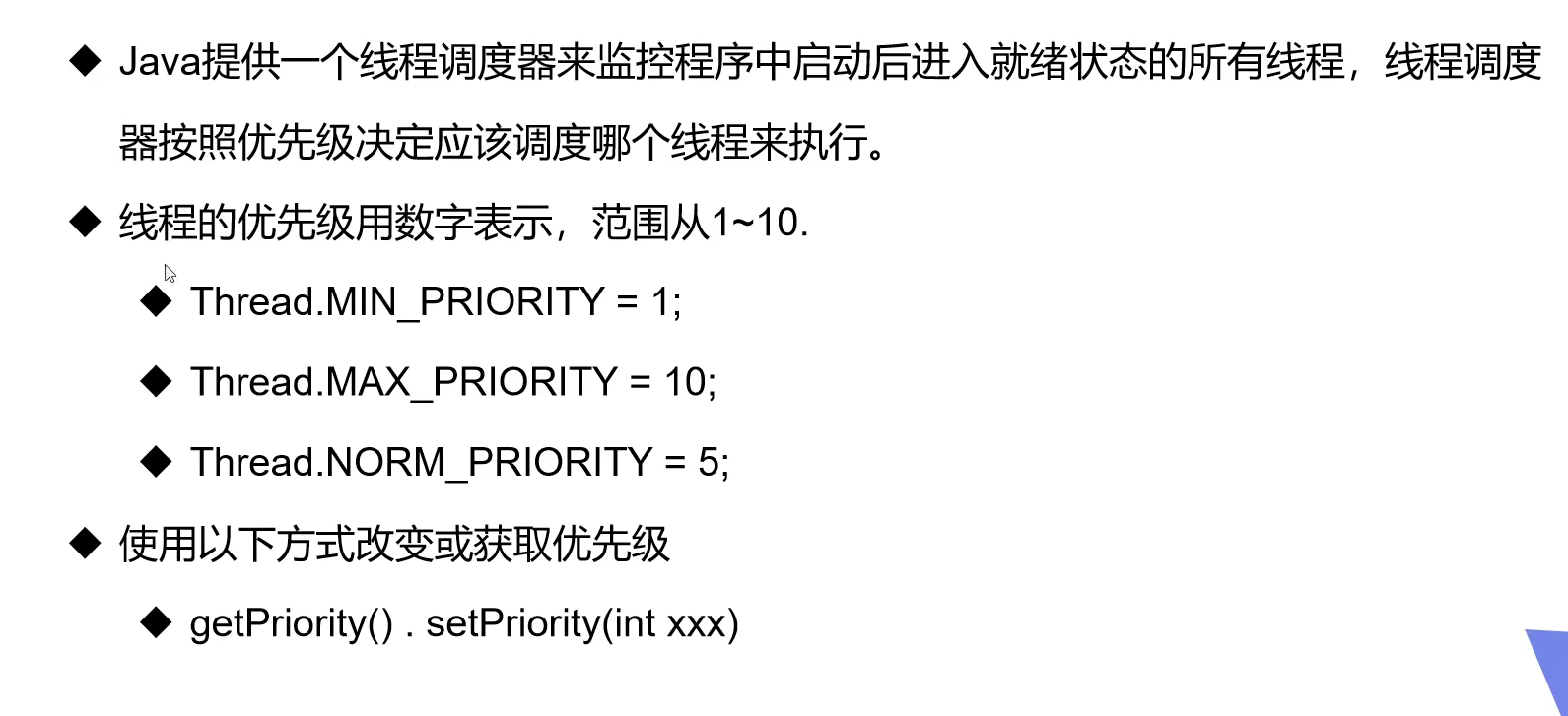
Example code:
package com.gavin.state;
public class TestPriority {
public static void main(String[] args) {
System.out.println(Thread.currentThread().getName() + "-->" + Thread.currentThread().getPriority());
MyPriority myPriority = new MyPriority();
Thread thread = new Thread(myPriority);
Thread thread2 = new Thread(myPriority);
Thread thread3 = new Thread(myPriority);
Thread thread4 = new Thread(myPriority);
Thread thread5 = new Thread(myPriority);
Thread thread6 = new Thread(myPriority);
//Set the priority of the thread before starting the thread
thread.start();
thread2.setPriority(3);
thread2.start();
thread3.setPriority(Thread.MAX_PRIORITY); //Thread.MAX_PRIORITY = 10
thread3.start();
thread4.setPriority(Thread.MIN_PRIORITY); //Thread.MIN_PRIORITY = 1
thread4.start();
thread5.setPriority(7);
thread5.start();
thread6.setPriority(8);
thread6.start();
}
}
class MyPriority implements Runnable{
@Override
public void run() {
System.out.println(Thread.currentThread().getName() + "-->" + Thread.currentThread().getPriority());
}
}
Execution results:

It can be seen that sometimes the execution order of threads is not executed according to the set priority. This is because the CPU operation speed is very fast and the CPU algorithm is optimized. These threads execute almost at the same time, and all printed priorities are not the priority set by themselves.
Daemon thread

Example code:
package com.gavin.state;
public class TestDaemon {
public static void main(String[] args) {
God god = new God();
You you = new You();
Thread thread = new Thread(god);
//The default is false, which means that it is a user thread. Normal threads are user threads
thread.setDaemon(true);
//God hand guard thread on
thread.start();
Thread thread2 = new Thread(you);
//Own user thread
thread2.start();
}
}
class God implements Runnable {
@Override
public void run() {
while (true) {
System.out.println("God bless you");
}
}
}
class You implements Runnable {
@Override
public void run() {
for (int i = 0; i < 36500; i++) {
System.out.println("Live happily every day!");
}
System.out.println("Farewell to the world! GoodBy~~~");
}
}
Execution results:

Thread synchronization mechanism
Concurrent interpretation:

Explanation of thread lock:
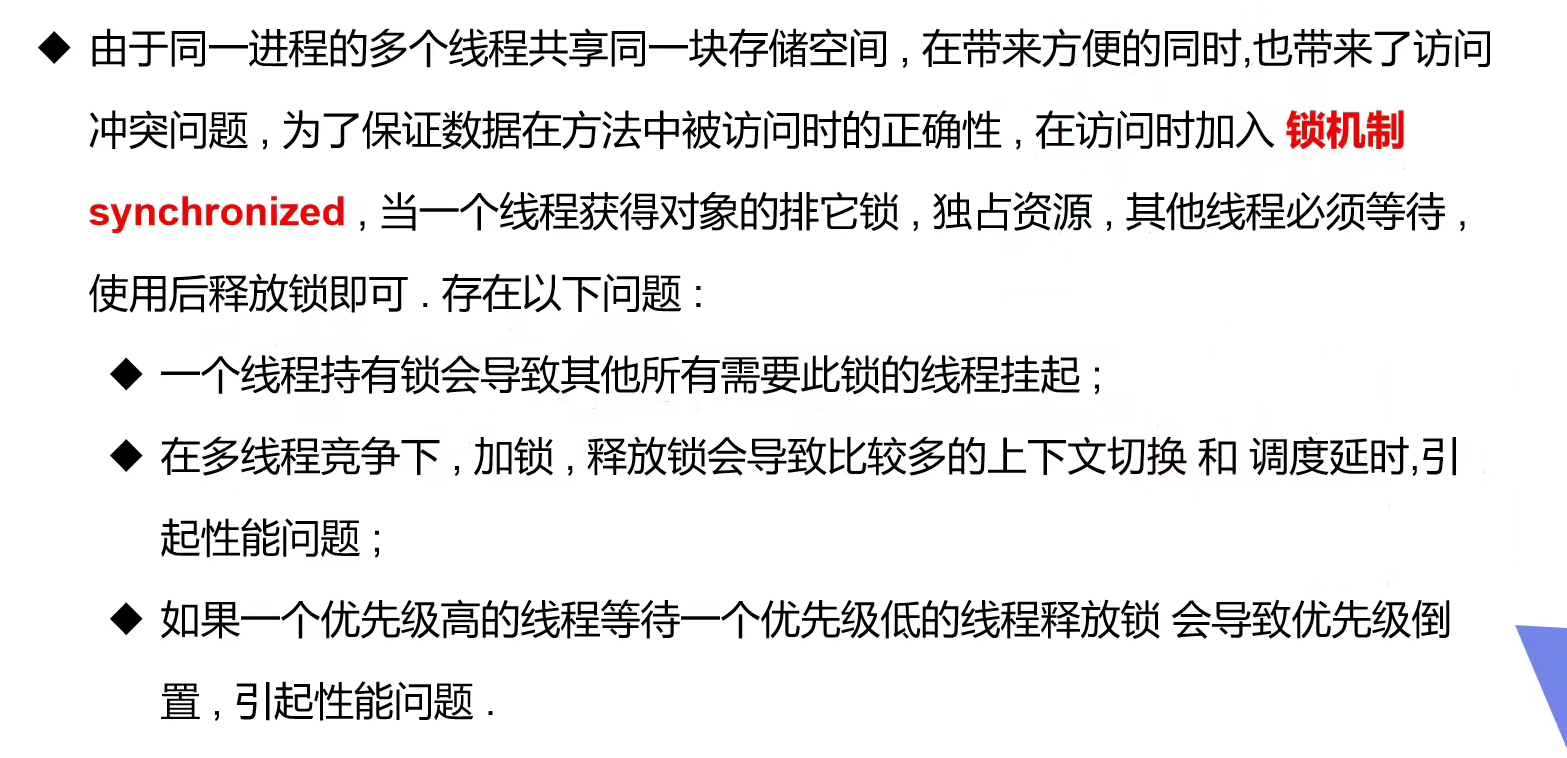
Thread unsafe cases
Bank withdrawal cases
Example code:
package com.gavin.syn;
public class UnsafeBank {
public static void main(String[] args) {
Account account = new Account("Marriage fund", 100);
Drawing drawing = new Drawing(account, 50, "you");
Drawing drawing2 = new Drawing(account, 100, "Your daughter-in-law");
drawing.start();
drawing2.start();
}
}
class Account {
String name;
int balance;
public Account(String name, int balance) {
this.name = name;
this.balance = balance;
}
}
class Drawing extends Thread {
Account account;
//How much did you withdraw
int drawingMoney;
//How much money do you have now
int nowMoney;
public Drawing(Account account, int drawingMoney, String name) {
super(name);
this.account = account;
this.drawingMoney = drawingMoney;
}
@Override
public void run() {
if (account.balance - drawingMoney < 0) {
System.out.println(Thread.currentThread().getName() + "There's not enough money to withdraw");
return;
}
try {
Thread.sleep(1000);
} catch (InterruptedException e) {
e.printStackTrace();
}
//Card balance
account.balance = account.balance - drawingMoney;
//The money in your hand
nowMoney = nowMoney + drawingMoney;
System.out.println(account.name + "The balance is:" + account.balance);
System.out.println(this.getName() + "Money in hand:" + nowMoney);
}
}
Execution results:

It can be seen that two threads withdraw money at the same time, and the balance becomes negative, resulting in major problems.
synchronized synchronization method
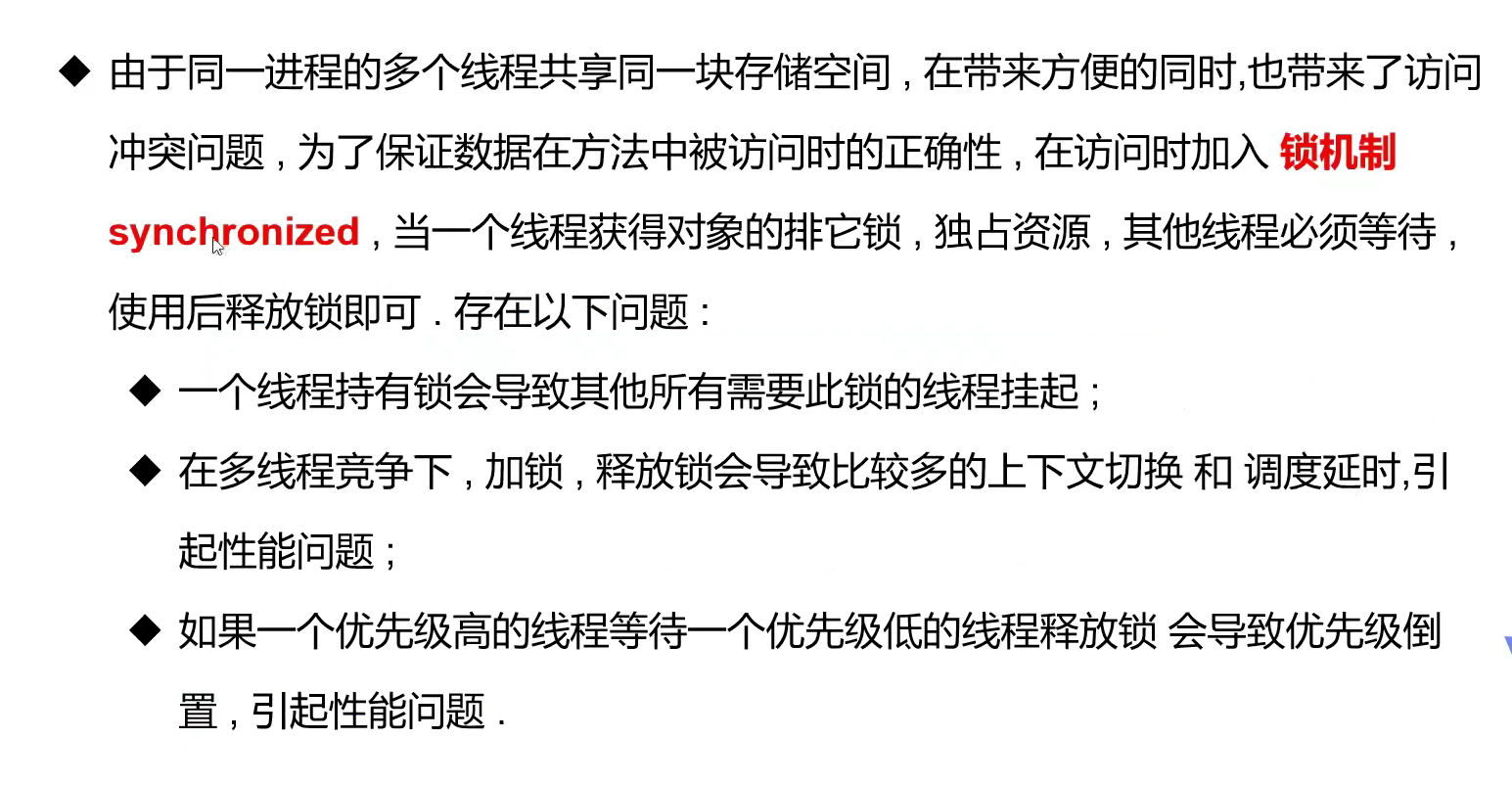
Optimize the ticket grabbing code with synchronized:
package com.gavin.Demo02;
//Multithreading operates on an object at the same time
//Example of buying a train ticket
public class TestRunnable3 implements Runnable{
//Number of votes
private int ticketNumber = 10;
@Override
public synchronized void run() {
while (true) {
if (ticketNumber <= 0) {
break;
}
try {
Thread.sleep(200);
} catch (InterruptedException e) {
e.printStackTrace();
}
System.out.println(Thread.currentThread().getName() + "-->Got the second" + ticketNumber-- + "Ticket");
}
}
public static void main(String[] args) {
TestRunnable3 testRunnable = new TestRunnable3();
Thread thread = new Thread(testRunnable, "Xiao Ming");
thread.start();
Thread thread2 = new Thread(testRunnable, "teacher");
thread2.start();
Thread thread3 = new Thread(testRunnable, "Scalpers");
thread3.start();
}
}
Execution results:

synchronized synchronization block
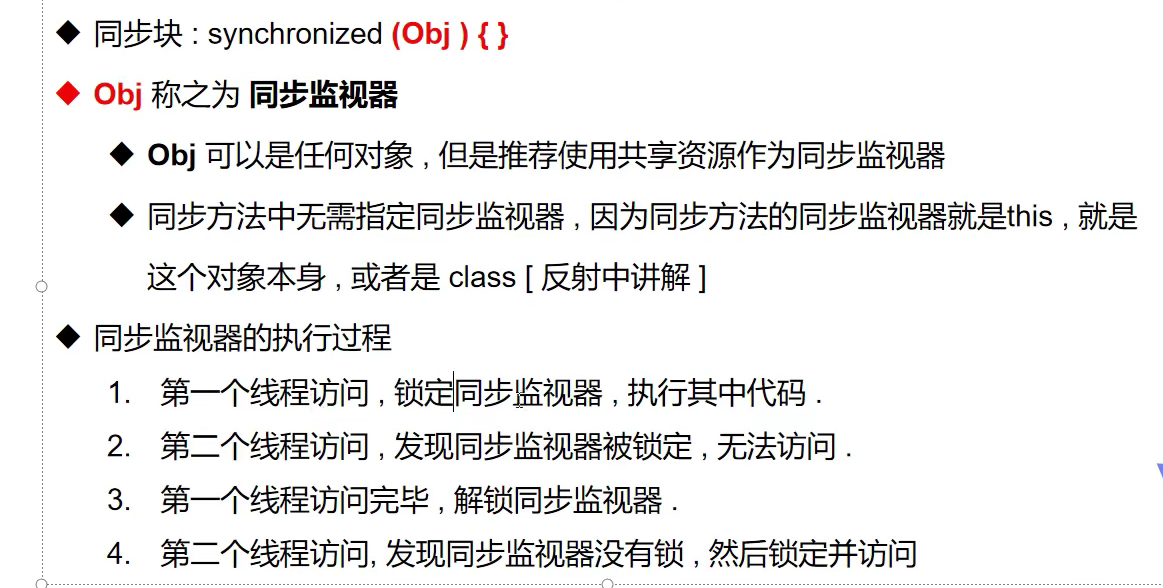
Optimize bank withdrawal codes using synchronized synchronization blocks:
package com.gavin.syn;
public class UnsafeBank {
public static void main(String[] args) {
Account account = new Account("Marriage fund", 100);
Drawing drawing = new Drawing(account, 50, "you");
Drawing drawing2 = new Drawing(account, 100, "Your daughter-in-law");
drawing.start();
drawing2.start();
}
}
class Account {
String name;
int balance;
public Account(String name, int balance) {
this.name = name;
this.balance = balance;
}
}
class Drawing extends Thread {
Account account;
//How much did you withdraw
int drawingMoney;
//How much money do you have now
int nowMoney;
public Drawing(Account account, int drawingMoney, String name) {
super(name);
this.account = account;
this.drawingMoney = drawingMoney;
}
@Override
public void run() {
synchronized (account) {
if (account.balance - drawingMoney < 0) {
System.out.println(Thread.currentThread().getName() + "There's not enough money to withdraw");
return;
}
try {
Thread.sleep(1000);
} catch (InterruptedException e) {
e.printStackTrace();
}
//Card balance
account.balance = account.balance - drawingMoney;
//The money in your hand
nowMoney = nowMoney + drawingMoney;
System.out.println(account.name + "The balance is:" + account.balance);
System.out.println(this.getName() + "Money in hand:" + nowMoney);
}
}
}
Execution results:

CopyOnWriteArrayList collection
The CopyOnWriteArrayList collection is thread safe. See the following example code for details:
package com.gavin.syn;
import java.util.concurrent.CopyOnWriteArrayList;
public class TestJUC {
public static void main(String[] args) {
CopyOnWriteArrayList<String> arrayList = new CopyOnWriteArrayList<>();
for (int i = 0; i < 10000; i++) {
new Thread(() -> {
arrayList.add(Thread.currentThread().getName());
}).start();
}
try {
Thread.sleep(3000);
} catch (InterruptedException e) {
e.printStackTrace();
}
System.out.println("CopyOnWriteArrayList The set length is:" + arrayList.size());
}
}
Execution results:

deadlock

Example code:
package com.gavin.thread;
public class DeadLock {
public static void main(String[] args) {
Makeup makeup = new Makeup(0, "Xiaolan");
Makeup makeup2 = new Makeup(1, "Xiaomei");
makeup.start();
makeup2.start();
}
}
//Lipstick
class Lipstick {
}
//Mirror class
class Mirror {
}
class Makeup extends Thread {
static Lipstick lipstick = new Lipstick();
static Mirror mirror = new Mirror();
int choice;
String girlName;
Makeup(int choice, String girlName) {
this.choice = choice;
this.girlName = girlName;
}
@Override
public void run() {
try {
makeup();
} catch (InterruptedException e) {
e.printStackTrace();
}
}
public void makeup() throws InterruptedException {
if (choice == 0) {
synchronized (lipstick) {
System.out.println(this.girlName + "Get lipstick");
Thread.sleep(1000);
synchronized (mirror) {
System.out.println(this.girlName + "Get the mirror");
}
}
} else {
synchronized (mirror) {
System.out.println(this.girlName + "Get the mirror");
Thread.sleep(2000);
synchronized (lipstick) {
System.out.println(this.girlName + "Get lipstick");
}
}
}
}
}
Execution results:

It can be seen that the program has entered a deadlock state
Four necessary conditions for deadlock generation:
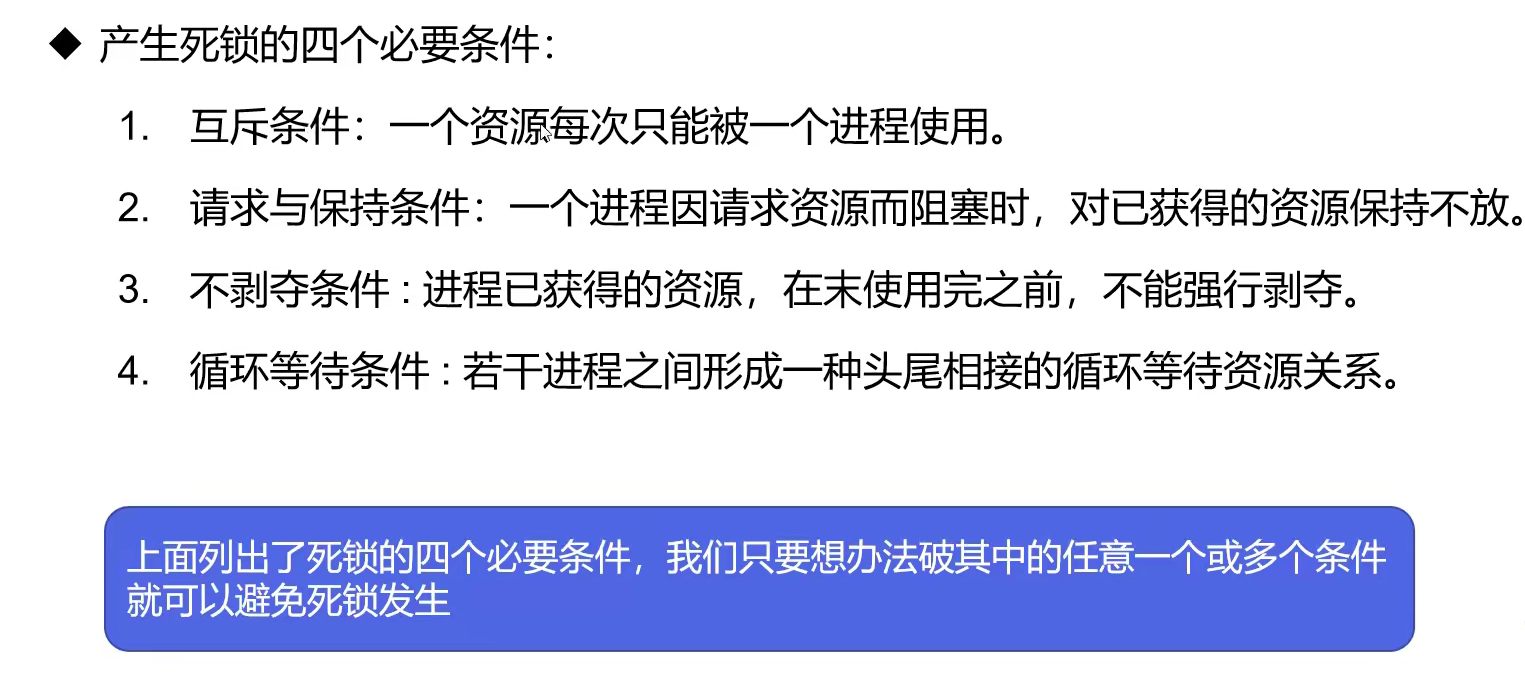
Lock lock
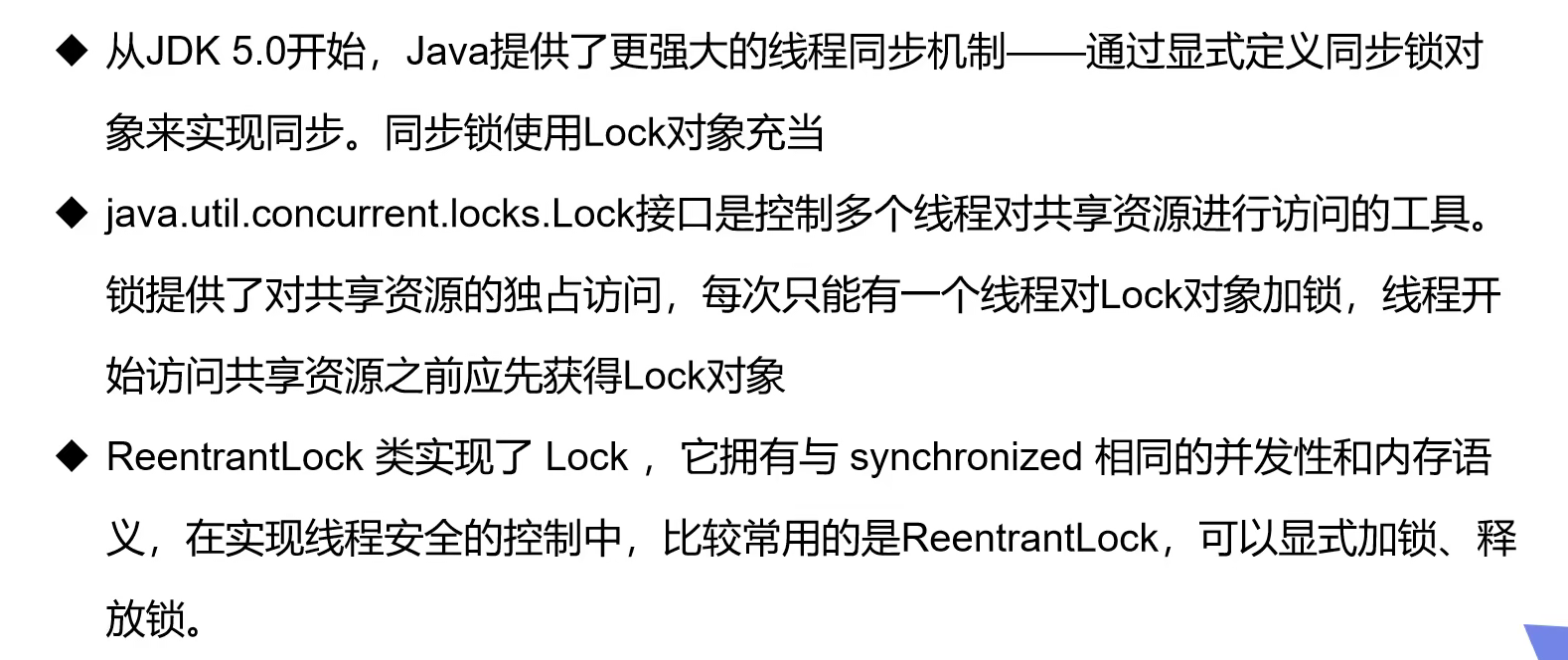
Example code:
package com.gavin.thread;
import java.util.concurrent.locks.ReentrantLock;
public class TestLock {
public static void main(String[] args) {
TestLock2 testLock2 = new TestLock2();
Thread thread = new Thread(testLock2);
Thread thread2 = new Thread(testLock2);
Thread thread3 = new Thread(testLock2);
thread.start();
thread2.start();
thread3.start();
}
}
class TestLock2 implements Runnable {
int tickNumber = 10;
//Define lock lock
private final ReentrantLock reentrantLock = new ReentrantLock();
@Override
public void run() {
while (true) {
try {
//Lock
reentrantLock.lock();
if (tickNumber > 0) {
System.out.println("Number of votes remaining:" + tickNumber --);
} else {
break;
}
} catch (Exception e) {
e.printStackTrace();
} finally {
//Unlock after thread execution
reentrantLock.unlock();
}
}
}
}
Execution results:

Differences between synchronized and Lock locks:
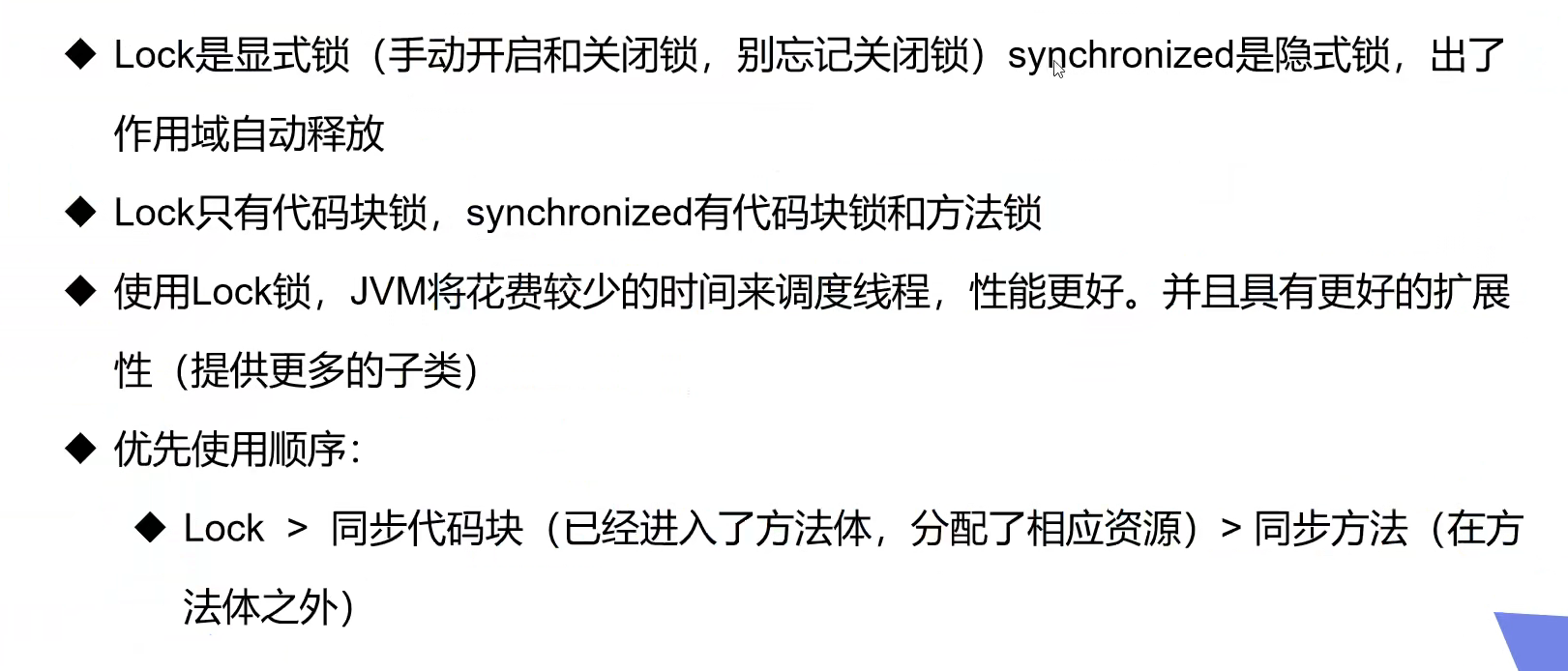
Producer and consumer issues
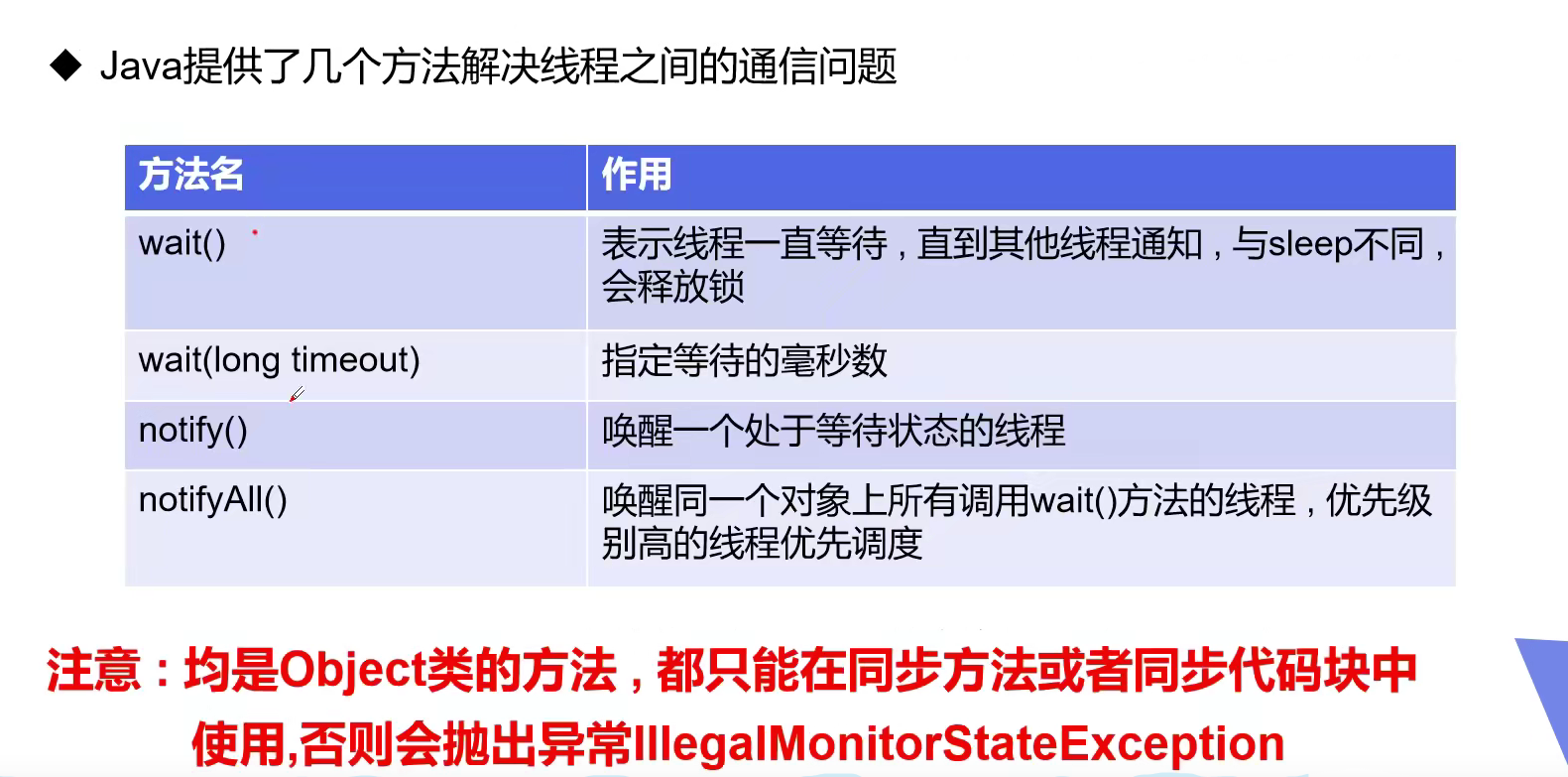
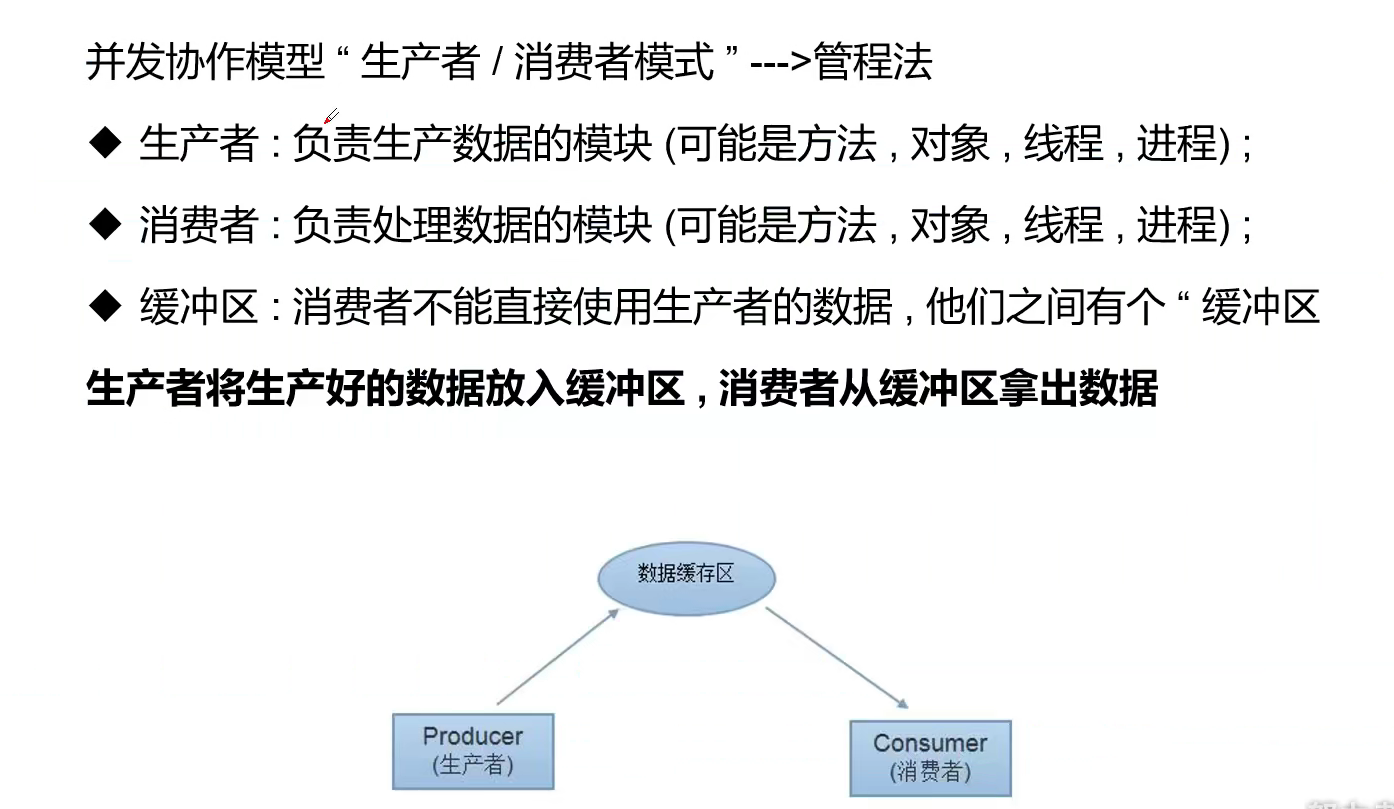
Application scenario:
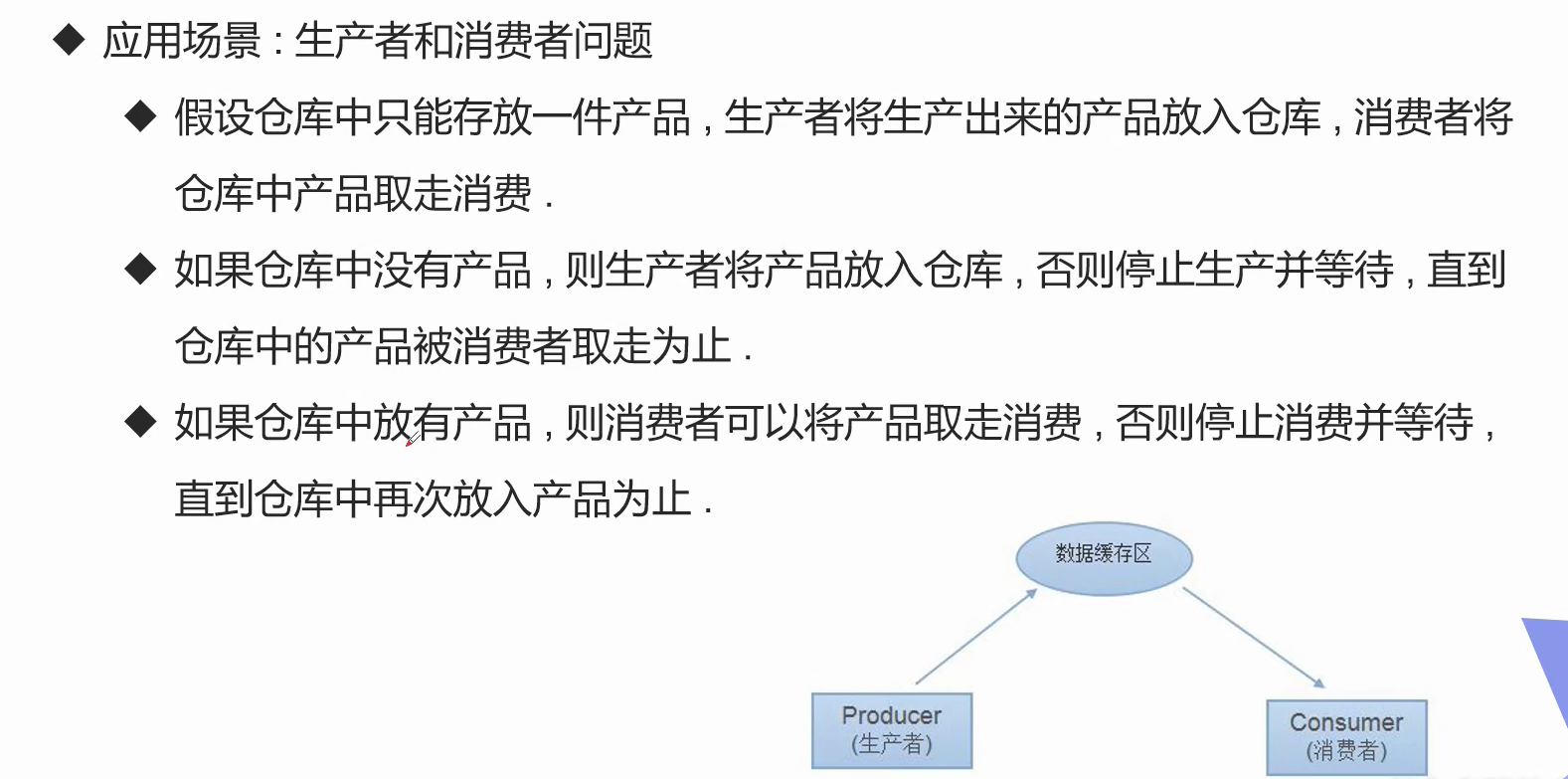
Pipe program method
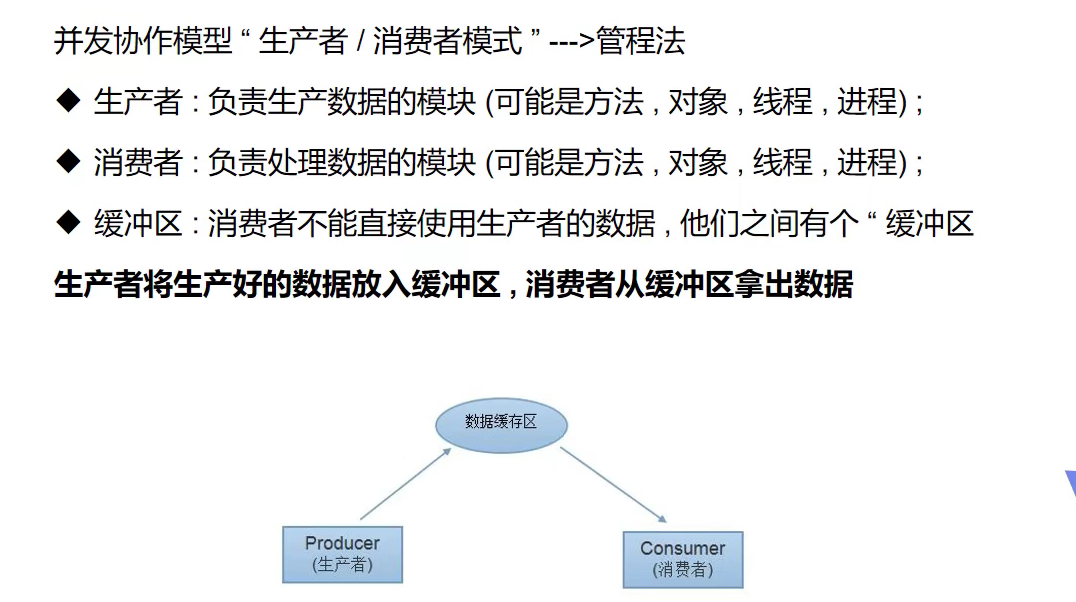
Example code:
package com.gavin.thread;
public class TestPC {
public static void main(String[] args) {
SynContainer synContainer = new SynContainer();
Product product = new Product(synContainer);
Customer customer = new Customer(synContainer);
product.start();
customer.start();
}
}
class Product extends Thread {
SynContainer synContainer;
Product(SynContainer synContainer) {
this.synContainer = synContainer;
}
@Override
public void run() {
for (int i = 0; i < 100; i++) {
synContainer.push(new Chicken(i));
System.out.println("Produced" + i + "Chicken");
}
}
}
class Customer extends Thread {
SynContainer synContainer;
Customer(SynContainer synContainer) {
this.synContainer = synContainer;
}
@Override
public void run() {
for (int i = 0; i < 100; i++) {
System.out.println("Consumption" + synContainer.pop().id + "Chicken");
}
}
}
class Chicken {
int id;
Chicken(int id) {
this.id = id;
}
}
class SynContainer {
Chicken[] chickens = new Chicken[10];
int count = 0;
public synchronized void push(Chicken chicken) {
//If the container is full, wait for the consumer to consume
if (count == chickens.length) {
try {
this.wait();
} catch (InterruptedException e) {
e.printStackTrace();
}
}
chickens[count] = chicken;
count++;
//Consumers can be informed of consumption
this.notifyAll();
}
public synchronized Chicken pop() {
//No, just wait for the producer to produce
if (count == 0) {
try {
this.wait();
} catch (InterruptedException e) {
e.printStackTrace();
}
}
//Consumption when there is
count--;
Chicken chicken = chickens[count];
//Inform the producer of production
this.notifyAll();
return chicken;
}
}
Execution results:

Signal lamp method:

Example code:
package com.gavin.thread;
public class TestPC2 {
public static void main(String[] args) {
TV tv = new TV();
Player player = new Player(tv);
Watcher watcher = new Watcher(tv);
player.start();
watcher.start();
}
}
class Player extends Thread{
TV tv;
Player(TV tv) {
this.tv = tv;
}
@Override
public void run() {
for (int i = 0; i < 20; i++) {
if (i % 2 == 0) {
this.tv.play("B station");
} else {
this.tv.play("Tiktok");
}
}
}
}
class Watcher extends Thread{
TV tv;
Watcher(TV tv) {
this.tv = tv;
}
@Override
public void run() {
for (int i = 0; i < 20; i++) {
this.tv.watch();
}
}
}
class TV {
//Name of the show
String voice;
//Actor performance logo
boolean flag = true;
public synchronized void play(String voice) {
if (!flag) {
try {
this.wait();
} catch (InterruptedException e) {
e.printStackTrace();
}
}
System.out.println("The actors performed:" + voice);
//Inform the audience to watch
this.notifyAll();
this.voice = voice;
this.flag = !this.flag;
}
public synchronized void watch() {
if (flag) {
try {
this.wait();
} catch (InterruptedException e) {
e.printStackTrace();
}
}
System.out.println("The audience watched:" + voice);
//Inform the actors to perform
this.notifyAll();
this.flag = !this.flag;
}
}
Execution results:

Thread pool
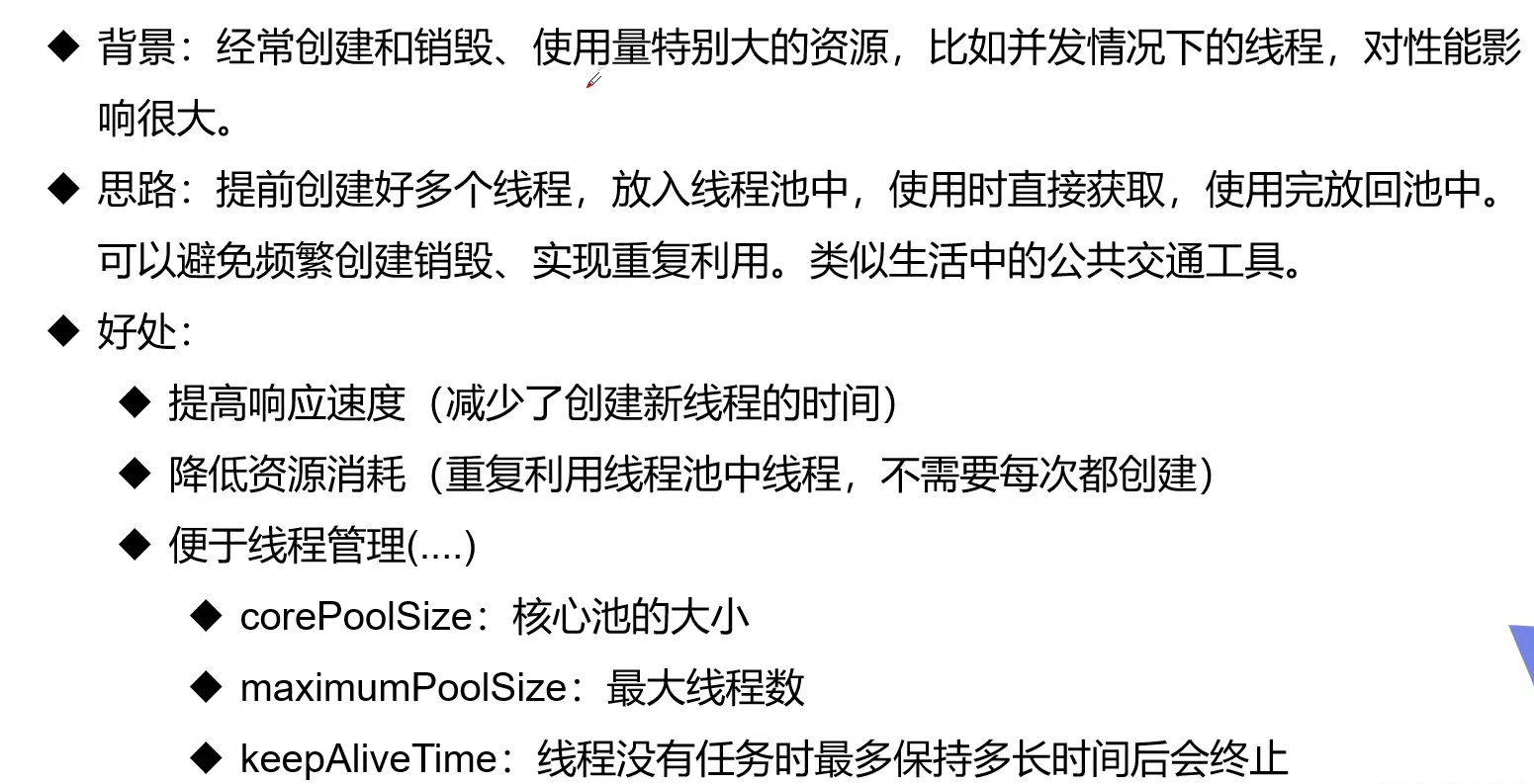
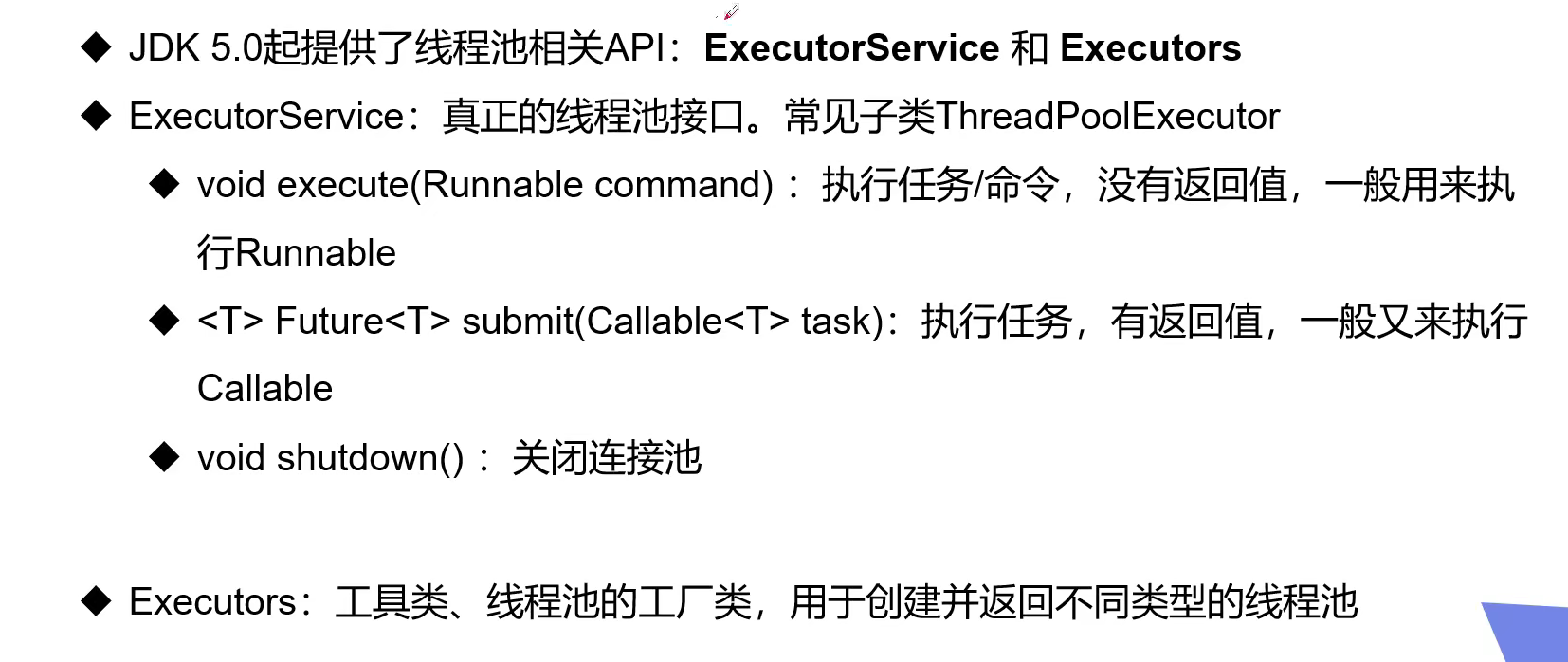
Example code:
package com.gavin.thread;
import java.util.concurrent.ExecutorService;
import java.util.concurrent.Executors;
public class TestPool {
public static void main(String[] args) {
//Create 10 threads
ExecutorService service = Executors.newFixedThreadPool(10);
//Execution thread
service.execute(new MyThread());
service.execute(new MyThread());
service.execute(new MyThread());
service.execute(new MyThread());
service.execute(new MyThread());
//Close thread
service.shutdown();
}
}
class MyThread implements Runnable {
@Override
public void run() {
System.out.println(Thread.currentThread().getName());
}
}
Execution results:

summary
Three ways to create threads
Example code:
package com.gavin.thread;
import java.util.concurrent.Callable;
import java.util.concurrent.ExecutionException;
import java.util.concurrent.FutureTask;
public class ThreadNew {
public static void main(String[] args) {
new MyThread1().start();
new Thread(new MyThread2()).start();
FutureTask<Integer> futureTask = new FutureTask<Integer>(new MyThread3());
new Thread(futureTask).start();
try {
Integer number = futureTask.get();
System.out.println(number);
} catch (InterruptedException e) {
e.printStackTrace();
} catch (ExecutionException e) {
e.printStackTrace();
}
}
}
class MyThread1 extends Thread {
@Override
public void run() {
System.out.println("MyThread1");
}
}
class MyThread2 implements Runnable {
@Override
public void run() {
System.out.println("MyThread2");
}
}
class MyThread3 implements Callable<Integer> {
@Override
public Integer call() throws Exception {
System.out.println("MyThread3");
return 100;
}
}
Execution results:
